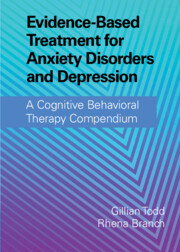 Evidence-Based Treatment for Anxiety Disorders and Depression
Evidence-Based Treatment for Anxiety Disorders and Depression Book contents
- Evidence-Based Treatment for Anxiety Disorders and Depression
- Evidence-Based Treatment for Anxiety Disorders and Depression
- Copyright page
- Contents
- Figures
- Tables
- Contributors
- 1 Introduction
- 2 The History and Philosophical Underpinnings of CBT:
- Part One Cognitive Behavioral Therapy for Anxiety Disorders
- Part Two Cognitive Behavioral Therapy for Posttraumatic Stress Disorder
- Part Three Cognitive Behavioral Therapy for Obsessive-Compulsive Disorder and Associated Disorders
- Part Four Cognitive Behavioral Therapy for Depression
- Part Five Complexity and Comorbidity in Anxiety Disorders and Depression:
- Part Six Specialist Applications of Cognitive Behavioral Therapy for Anxiety Disorders and Depression
- Part Seven Future Developments
- Appendices
- Index
- References
1 - Introduction
Published online by Cambridge University Press: 06 January 2022
- Evidence-Based Treatment for Anxiety Disorders and Depression
- Evidence-Based Treatment for Anxiety Disorders and Depression
- Copyright page
- Contents
- Figures
- Tables
- Contributors
- 1 Introduction
- 2 The History and Philosophical Underpinnings of CBT:
- Part One Cognitive Behavioral Therapy for Anxiety Disorders
- Part Two Cognitive Behavioral Therapy for Posttraumatic Stress Disorder
- Part Three Cognitive Behavioral Therapy for Obsessive-Compulsive Disorder and Associated Disorders
- Part Four Cognitive Behavioral Therapy for Depression
- Part Five Complexity and Comorbidity in Anxiety Disorders and Depression:
- Part Six Specialist Applications of Cognitive Behavioral Therapy for Anxiety Disorders and Depression
- Part Seven Future Developments
- Appendices
- Index
- References
Summary
The efficacy of disorder-specific cognitive behavioral therapy (CBT) treatment protocols for anxiety and depression is well established. This state-of-the-art compendium brings together, in one volume, a therapist guide to treating anxiety disorders, posttraumatic stress disorder, obsessive compulsive disorder (including six subtypes), and depression. Treatment protocols are based on the DSM-5 taxonomy diagnoses that address the nuances of specific clinical presentations. There is section on case formulation and treatment planning to assist therapists when working with clients presenting with complexity and comorbid disorders. Specific CBT approaches and treatment protocols for diverse populations with common mental health problems are also provided. Experts in their field from around the world have shared their protocols and wisdom to enable the reader (1) to develop their knowledge base of current research, (2) to understand the phenomenology of psychological disorders, (3) to learn idiosyncratic additions to the assessment process, (4) to follow a step-by-step guide to treatment, (5) to identify and overcome common problems in treatment, and (6) to effectively evaluate treatment progress. The compendium is written in an accessible style that lends the reader a sense of having an expert clinical supervisor educating and guiding, helping to build knowledge and skill.
Keywords
- Type
- Chapter
- Information
- Evidence-Based Treatment for Anxiety Disorders and DepressionA Cognitive Behavioral Therapy Compendium, pp. 1 - 5Publisher: Cambridge University PressPrint publication year: 2022
